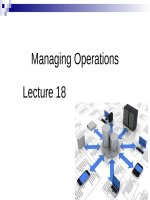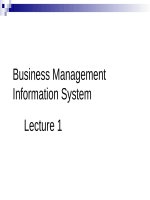Lecture Business management information system - Lecture 9: Information systems planning
Bạn đang xem bản rút gọn của tài liệu. Xem và tải ngay bản đầy đủ của tài liệu tại đây (1.21 MB, 53 trang )
Information Systems Planning
Lecture 9
Today Lecture
n
Case examples include Microsoft
n
Introduction
¨ Types of planning
¨ Why
is planning so difficult?
Today Lecture ..
n
The Changing World of Planning
¨ Traditional
¨ Today’s
Strategy-Making
Sense-and-Respond Approach
Introduction
n
Systems planning, especially strategic systems planning,
is becoming more difficult and more important at the same
time. Technology is changing so fast that it is seems futile
to plan for it, yet the dependence on this technology
makes planning its effective use a matter of organizational
life and death
n
This lecture / chapter contrasts the traditional view of
planning with the sense-and-respond approach of
strategy-making, presenting seven IS planning techniques
Introduction
n
IS management is becoming more difficult and more
important at the same time:
¨ Technology changing so fast: “Why bother?” Vs. Most
organizations’ survival is dependant on technology
¨ How to resolve this apparent paradox?
n
Good News = variety of approaches, tools and
mechanisms available
Bad News = no ‘best’ way to go about it
n
Planning ..Good and Bad News!
Introduction cont.
n
It is important to establish the appropriate mindset for
planning:
¨ Some managers believe = “determining what
decisions to make in the future”
¨ Better view = developing a view of the future that
guides decision making today
¨ Subtle
difference = ‘strategy making’
n Strategy = stating the direction in which you want to
go and how you intend to get there
¨ The result of strategy-making is a plan
Why Planning Is So Difficult
Types of Planning:
n Planning is usually defined in three forms,
which correspond to the three planning
‘horizons’. (Figure 4-1)
¨ Strategic
= 3-5 years
¨ Tactical = 1-2 years
¨ Operational 6 months – 1 year
4-8
Why Planning Is So Difficult
Types of Planning:
n
Planning is usually defined in three forms, which
correspond to the three planning ‘horizons’. (Figure 4-1)
¨ Strategic = 3-5 years
¨ Tactical = 1-2 years
¨ Operational 6 months – 1 year
Types of Planning
Introduction cont.
n
Why Planning Is So Difficult?:
¨ Business
§
Goals and Systems Plans Need to Align
Strategic systems plans need to align with business
goals and support those objectives
§
Some believe = “too sensitive” = PROBLEMS
§
Fortunately = trend for CIOs to be part of senior
management
Introduction cont.
¨ Technologies Are
§
Rapidly Changing
How can you plan when information technologies
are changing so rapidly
¨ Continuous
planning?
¨ Old days of planning at ‘start of year’ = gone
¨ Advanced technology groups
Introduction cont.
n
Why Planning Is So Difficult ...
¨ Companies
§
Need Portfolios Rather Than Projects
Evaluation on more than their individual merit
¨ How
they fit into other projects and how they
balance the portfolio of projects
¨ Infrastructure
§
Development is Difficult to Fund
Despite everyone “knowing infrastructure
development is crucial”, it is extremely difficult to
get funding just to develop or improve
infrastructure
Introduction cont.
§
Often done under the auspices of a large
application project
¨ Challenge = develop improved applications and
improve infrastructure over time
¨ Responsibility
§
Needs to be Joint
Business planning, not just a technology issue
¨ Other
§
§
planning issues
Top-down Vs. bottom-up; radical change Vs.
continuous
Planning culture
Business Goals and Systems Plans
n
Strategic systems plans need to align with business
goals and support them.
n
If top management believes the firm’s business goals are
extremely sensitive, the CIO is often excluded in major
strategic meetings by top management.
Business Goals and Systems Plans
conti
n
Systems planning is becoming a shared responsibility
among the CIO, CTO, and other members of senior
management.
n
The emergence of e-commerce and globalization caused
CEOs and CFOs to realize they need to be involved in
systems planning
Technologies Are Rapidly Changing
n
How can executives plan when IT is changing so rapidly:
q
Continuous monitoring and planning the changes of
technologies and how the industry would adopt this
technology
q
The planning process first needs to form a best-available
vision of the future on which to base current decisions.
Technologies Are Rapidly Changing
Conti
n
The technology needs to be monitored to see whether
that future vision needs alteration.
n
Some organizations have an advanced technology
group charged with watching and evaluating new
technologies.
n
It is important for organizations to pay particular attention
to the impact of disruptive technologies or disruptive
innovation
n
Technologies Are Rapidly Changing
Conti
Sometimes, an emerging and inexpensive technology
emerges and swiftly displaces incumbent technologies.
n
A classic example is the Linux Operating System (OS).
When it was introduced, its capability was inferior to
other existing OSs like Unix and Windows NT.
n
Linux was inexpensive, and thanks to continuous
improvements, it has earned a significant market share
for computer servers
n
Technologies Are Rapidly Changing
Conti
. In 2007, IBM announced it would use Linux with its new
servers.
n
The USB memory stick is another instance of disruptive
technologies.
n
This inexpensive storage medium has changed the way
people share files, displacing disk storage.
n
Many forecasters have predicted that Voice-over-IP will
replace decades-old land-based telephony
Technologies Are Rapidly Changing
Conti
n
The planning issue here is for management to foresee
the upcoming of innovation with superior technology
potential and viable business applications.
n
These new technologies can be a cost-effective addition
to the existing technological infrastructure.
n
Or, they can be a potential replacement that needs a
carefully migration strategy
Companies Need Portfolios Rather Than
Projects
n
Another planning issue is the shift in emphasis from
project selection to portfolio development.
n
Businesses need a set of integrated and seamless
technologies that work together.
n
Project developments have had a history of building
“stove-pipe” systems that result in applications that are
not compatible with each other.
Companies Need Portfolios Rather Than
Projects ..
n
A portfolio approach requires a more sophisticated form
of planning because projects must be evaluated on more
than their individual merits.
n
How they fit with other projects and how they balance
the portfolio of projects become important.
n
The Internet Value Matrix described later is an example
of this approach
Infrastructure Development Is Difficult
to Fund
n
People understand intuitively that developing an
infrastructure is crucial
n
. However, it is extremely difficult to determine how much
funding is needed to develop or improve infrastructure.
n
Often, such funding must be done under the auspices of
large application projects.
n
The challenge then is to develop improved applications
over time so that the infrastructure improves over time
Infrastructure Development Is Difficult to
Fund conti
n
Since the mid-1980s, companies have faced a continual
succession of large infrastructure investments.
n
First, they needed to convert from a mainframe to a
client-server architecture to share corporate and desktop
computing.
n
Then they implemented ERP to centralize and
standardize data so that everyone had the same
information.









